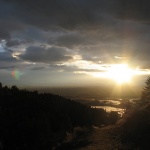Lawsuit over Seeley timber sale reveals split among environmental groups
Posted: October 2, 2011Source: Missoulian
A lawsuit challenging a timber sale north of Seeley Lake shows either the U.S. Forest Service can’t follow the law or some environmental groups can’t agree to work together.
The Alliance for the Wild Rockies, Friends of the Wild Swan, Montana Ecosystem Defense Council and Native Ecosystems Council all sued the Forest Service over the Colt Summit Forest Restoration and Fuels Reduction Project on Friday.
The project would thin trees and remove roads on more than 4,000 acres between Lake Alva and Summit Lake along Montana Highway 83.
The lawsuit has angered members of several groups who support a collaborative effort to achieve both commercial logging and habitat restoration in the Seeley-Swan area. The Colt Summit was one of the tests of the Montana Forest Restoration Committee’s ability to move forward without legal challenges.
“I tend to be on the side of the coin where, if you bring a lot of people who don’t think a lot alike and take time to learn about the projects, we collectively can come up with better ideas,” said Anne Dahl of the Swan Ecosystem Center, one of the project’s supporters. “I think the Friends of the Wild Swan and others are more leery of collaboration. There’s sort of a fundamental philosophy where we’re different.”
“There’s no provision in there that says if 80 percent of the people sign off on it, they don’t have to follow the law,” responded Michael Garrity of Alliance for the Wild Rockies. “They have to show it’s benefiting wildlife.”
The project affects 4,330 acres in an area known to be a major wildlife corridor. About 740 acres would be logged and thinned, including 137 acres of old-growth forest. Another 1,216 acres would have the understory cleared and burned. In some areas, 19 acres would be clearcut to improve visitors’ views of the Swan Mountain Range and 69 acres would get “shelterwood patch cuts” that mimic forest openings.
The Forest Service would decommission 4.1 miles of road, turning a stretch of the Colt Summit Road into a snowmobile trail. Another 5.1 miles would be reconstructed and linked into the snowmobile network. After the five-year project is over, 28.4 miles of temporary and winter-haul roads would be decommissioned.
For weed control, crews would spray herbicide on 34 miles of roads in the area, as well as all logging and other work areas.
The area is also prime habitat for grizzly bear, lynx and bull trout. Dahl said in her tours of the project, she believed the changes would benefit threatened and endangered species.
***
But the lawsuit alleges the Forest Service failed to take those animals’ needs into account when it planned the project.
Sara Jane Johnson was a Forest Service wildlife biologist before she became director of the Native Ecosystem Council. In a statement, she argued that removing beetle-killed trees hurt habitat more than helped it, because it took away nesting areas and cover used by everything from woodpeckers to lynx and grizzly.
The lawsuit also argues the Forest Service was supposed to perform a full environmental impact statement and evaluate how it fares under the National Forest Management Act and National Environmental Policy Act.
“Why do we win 85 percent of our lawsuits?” Garrity asked rhetorically. “We sued the Forest Service more than any other environmental group in the country and we won more than any other group. We raise the same issue every time they log on grizzly bear habitat because they have the same problem.”
University of Montana College of Forestry and Conservation Dean Jim Burchfield was part of the Lolo Restoration Committee and reviewed the Colt Summit project for inclusion in the Southwest Crown of the Continent Collaborative Forest Landscape Restoration Project proposal. That was one of 10 forest stewardship projects nationwide to receive funding from Congress last year.
“In my view, the Colt Summit project is about seeing how people with very different views of management priorities can come up with a project,” Burchfield said. “To fight the timber wars over every single timber sale is really counterproductive to the interests of most Montanans. There was an effort to be very careful in the development of that sale. They were looking at the most controversial areas and making sure all the laws and regulations were adhered to.”
Garrity disagrees.
“On this timber sale, we haven’t had a worse timber sale meeting,” he said. “They didn’t listen to anything we said. They just told us, ‘We’re fully funded on this and we’re pushing forward.’ ”
“There were other ones up there, and we didn’t oppose them,” Garrity continued. “One other sale was more in the urban interface, and we want them to do thinning near homes, not in critical lynx habitat. Over on the Flathead (National Forest), there’s a timber sale that adjoins this one. The boundaries touch, but they didn’t analyze for cumulative impacts. That’s one of the things they’re required to do.”

